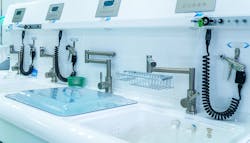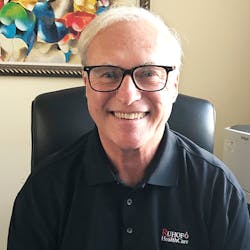Ergonomics in endoscopy reprocessing requires rigid flexibility
When you have to clean, disinfect, sterilize, store and handle very delicate, sensitive and complex devices like endoscopes, it can be easy to overlook some of the obvious issues in the process.
That’s because the intricate process of reprocessing endoscopes and other endoscopic devices involves disassembling the devices to a degree, as well as conducting detailed inspections of products along the way.
Performing these tasks can be stressful on Sterile Processing and Distribution (SPD) technicians, particularly in the physical areas of gait between stations, posture at workstations and standing for long periods of time.
As a result, ergonomics should be considered a serious factor.
Much depends on the departmental footprint and workspace design, according to Melissa Kubach, Clinical Education and Training Manager, Mobile Instrument Service & Repair.
“People do jobs well when they are well trained, practice the process regularly and have the resources to make the job easy to do,” she noted. “Installing sinks and working counter space that can adjust to accommodate the reprocessing technicians’ height is a big help. Also, cleaning is improved with the use of automated flushing devices to limit repetitive motion.”
“The long scopes require large, deep sinks that the height needs to be adjusted to accommodate a wide range of individuals,” Azizi indicated. “The high-demand, fast-paced department could [and] will cause additional stress.”
Azizi specified the need for height-adjustable sinks and tables, an “assembly line approach” to reprocessing for high-demand departments and “a quality control person to verify 100 percent enhanced visual inspection after cleaning.”
“Newer cleaning equipment and aids, such as trough-type sinks that allow the flexible endoscope to be stretched out versus coiled and flush/suction devices like Scope Buddy Plus, greatly assist the technician handling and processing of flexible endoscopes,” Agoston said. “Pass-through AERs that allow for separation between the dirty and clean area are a great help as well as the Medivators horizontal storage cabinets that automate the tracking of the endoscopes [and] extend hang time to 30 days are a great benefit. Advances like these greatly enhance the likelihood that endoscope reprocessing will be done correctly.”
“The device manufacturers must work with end users to design products that meet all the necessary guidelines to allow for cleaning and safe use,” he said. “Unfortunately, it comes down to the analysis of costs versus the quality of the outcome.”
Several manufacturers contend they already are working with end users by designing and delivering a different kind of product that doesn’t involve such detailed and intricate cleaning.
“As a manufacturer of single-use rigid scopes, we put a lot of energy into ergonomics relative to the user,” Cripe said. “Many times these ‘human factors’ are the most important in driving adoption and can be a significant challenge to incorporate the right combination of function and form. As it relates to cleaning/sterilization, this obviously is not considered since all single-use products are sterilized during the manufacturing process.”
- Outlook Endoscopy: What’s next for endoscope reprocessing and device design?
- Looking ahead at endoscope reprocessing quality performance
- Techniques and tips for aeration, drying and storage
- Why ergonomics should not be over- looked
- Advance SPD to include higher-paid specialist teams
- The true colors of hydrogen peroxide sterilization chemical indicator strips
- Periscope: Color-coded standard needed for hydrogen peroxide sterilization indicator strips
- Endoscope Care in 2020 and beyond
About the Author
Rick Dana Barlow
Senior Editor
Rick Dana Barlow is Senior Editor for Healthcare Purchasing News, an Endeavor Business Media publication. He can be reached at [email protected].







